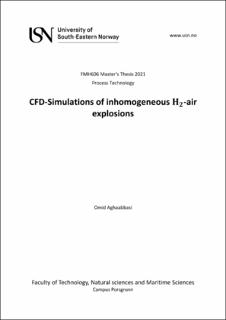| dc.description.abstract | Since demands for energy resources increase globally in recent years due to growth of application consumption, finding alternative resources for traditional fossil fuels raises. These current fuels are diminishing continuously and have huge pollutions and destructive environmental effects on creature and also human lives. Among renewable and green alternative fuels, hydrogen fuel is introduced as a promising and zero emission energy carrier which is accessible and clean that also known as future fuel. Due to low ignition energy required for hydrogen combustion, abrupt explosions are inevitable. So, safety study of -air explosion has specific importance to reduce unexpected incidents. Based on various initial conditions, configuration and dimension of studied geometry, different explosion regimes can be observed. Also, inhomogeneous conditions for -air mixture are more realistic in the world due to stratification of in air based on low density. So, inhomogeneous -air mixture explosion is highly considered in research studies such as safety aspects.
In this project, in order to simulate flame acceleration of explosions in channel, openFOAM CFD toolbox has been employed as reliable numerical simulation method. For this reason, 6 simulation cases have been executed by XiFoam solver within a 1700*100 2D channel and without presence of obstacles. It was applied a high enough aspect ratio of length to height to be sure of stronger explosion. Homogeneity and inhomogeneity effects in -air explosions have been investigated in this work with further consideration of stoichiometric, lean, and rich fuel conditions by implementing different equivalence ratio. First homogeneous -air mixture has been considered which implemented in whole domain of geometry. Then inhomogeneous -air mixture has been investigated by making two homogeneous layers in channel as hydrogen-air flammable cloud in half top of channel and air as inert gas in half bottom of it.
In these explosion scenarios, flame acceleration in the channel has been investigated by considering some key parameters such as flame front position, flame speed and pressure.
Results of these parameters show that with more fuel concentration by increasing equivalence ratio and going from fuel-lean to fuel-rich condition, flame front goes faster with higher velocity and pressure. This behavior is similar for both homogeneous and inhomogeneous -air mixtures. Furthermore, since there is more flammable -air mixture in homogeneous case than inhomogeneous one and flame can freely stretch in this condition, flame elongates and consequently results to enlargement of flame surface area with higher reaction rates. So, flame exhibits higher acceleration, velocity, and pressure in this condition rather than inhomogeneous one. | |
